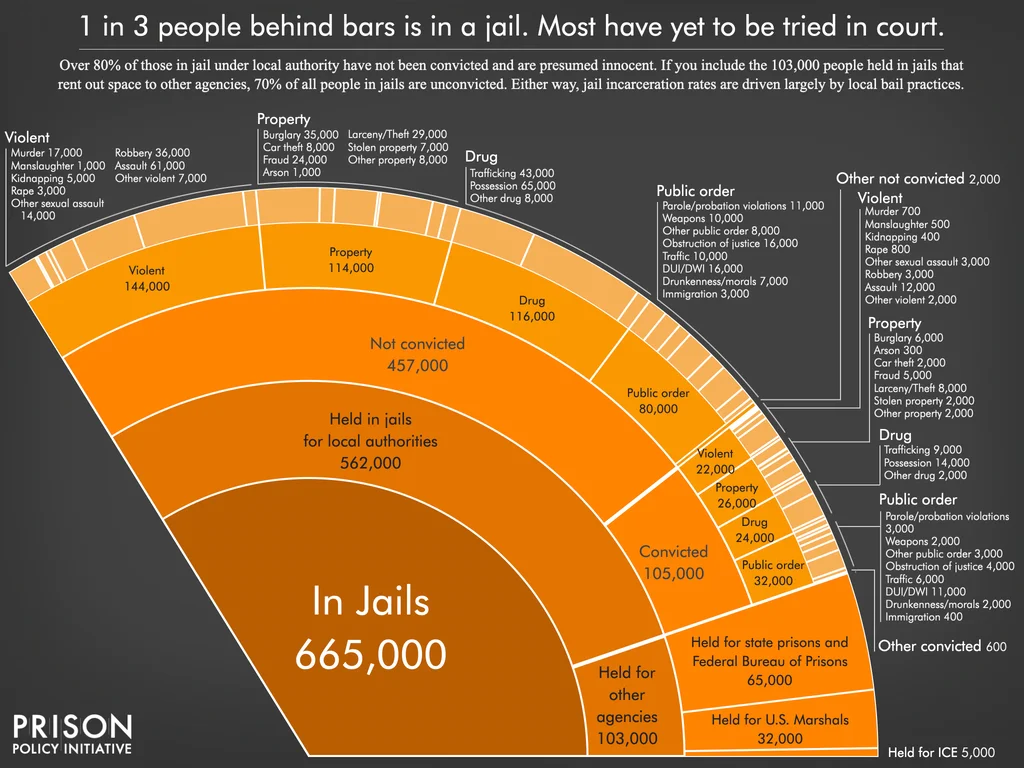7.7 Who Goes to Jail?
David Carter; Michelle Holcomb; and Kate McLean
One of the more troubling aspects of jails in the United States is the diverse population that gets placed within them. The short description is: everyone. Whenever someone is arrested, this typically starts their process in the criminal justice system. While it might not be the first time they have been arrested, this action places them en route to a jail. Thus, jails are a collection point for many differing agencies, including the County Sheriff’s Office and municipal or local police. State police may send individuals directly to jail, and even federal agencies may use local jails as a point of entry. For example, ICE (Immigration and Customs Enforcement) houses many thousands of ICE-holds in jails across the country. At the end of the day, jails hold all kinds of individuals. While this list is not comprehensive, it does represent many of the populations held in jails:
- Felons and misdemeanants
- First-time and repeat offenders
- Those awaiting arraignment or trial
- The accused and convicted
- Parolees stepping down from prison
- Juveniles pending transfer
- Individuals with mental illness awaiting transfer
- Individuals with alcohol and substance use disorders
- Detainees for the military
- Detainees for federal agencies
- Individuals in protective custody
- Witnesses
- Individuals in contempt of court
- Detainees awaiting transfer to state, federal, or other local authorities
As one can see from this list, there are many types of people in the country’s 3,300-plus jails at any given time. In fact, on any given day, there are over 650,000 individuals in jail in the United States. This daily census has steadily increased since the 1970s, with some decrease during the COVID-19 pandemic; over the past decade, however, daily jail populations have generally fluctuated between 725,000 to 750,000 inmates. Of course, this is only one portion of the people who enter jail annually. It is estimated that roughly 11 million people are processed through America’s jails each year. Average lengths of stay vary by jurisdiction, but a good estimate is roughly 25 days in jail for each individual. As Wagner and Sawyer (2025) show in this graphic, the types of people in jail at a point in time is varied:

Probably one of the most notable items in the snapshot above is the proportion of individuals that have not been convicted. Roughly 81% of individuals in jails at any given time have not been convicted of a crime, nor sentenced. Other notable groups are individuals held for other agencies. This could be a matter of processing time or allocations of bed space. Still, jails only make up one portion of the brick-and-mortar approach to punishment. Prisons are the other large part.
Think About It
As noted above, an average jail stay in the United States is estimated at 25 days. While this may not seem like an extraordinary amount of time, think about what might happen if you were taken out of your life for just under one month.
- What would happen with your current classes? Your GPA? Your college progress and financial aid?
- What would happen with your job if you couldn’t appear for over 3 weeks?
- What would happen with your family? Who would feed your pets or take your children to school?
- What would happen with your house or housing? Would your rent or bills be taken care of?

